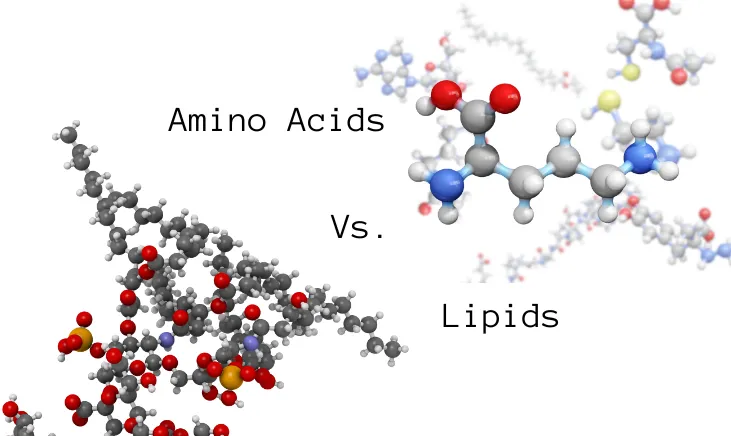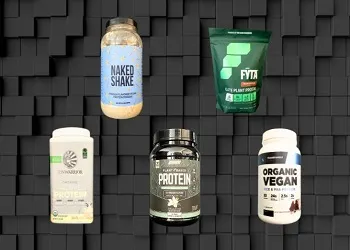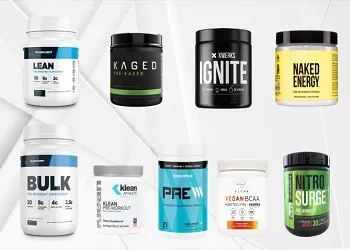Amino acids and lipids are two terms that are thrown around in the health and fitness world. As a dietitian with a nutrition research, writing, and coaching background, I often get asked about different nutrients, including amino acids and lipids.
In this article, I’ll break down what each one does, show their differences, and explain why having both in our diets is essential.
Table of Contents
Amino Acids and Lipids: What Are They?
When understanding the fuel for our bodies, amino acids and lipids stand out as two major players in nutrition. If you’ve been in the health or fitness world, you may have heard that amino acids are the building blocks of proteins or that lipids are the fats that provide energy, but what does that mean?
Are Amino Acids and Lipids the Same?
Amino acids and lipids are critical to our well-being, yet they serve distinct bodily roles characterized by their unique molecular structures and functions.
Amino acids are made of amino and carboxyl groups, which link in sequence, constructing the complex proteins essential for our body’s structure and function. These proteins are fundamental to our physiological processes, from muscle repair to enzyme function.
On the other hand, lipids, including fats, oils, and cholesterol, are made by chains of carbon atoms, hydrogen atoms, and oxygen atoms. Their hydrophobic nature makes them insoluble in water, distinguishing their role from amino acids. They are integral to energy storage, cellular membrane formation, and hormone production, reflecting their indispensable contribution to maintaining the body’s integrity and metabolic balance.
Amino Acids

Amino acids are well-known for their connection to protein. They are the essential components that proteins are made of. Without amino acids, the proteins in our bodies wouldn’t be able to carry out the critical functions they perform every day.
Amino Acids 101
Amino acids are organic compounds that bond together to form proteins. There are 20 amino acids, some being essential and others non-essential. These compounds are like letters in an alphabet that can be combined in infinite ways to create the “words” or proteins that do different jobs in our bodies.
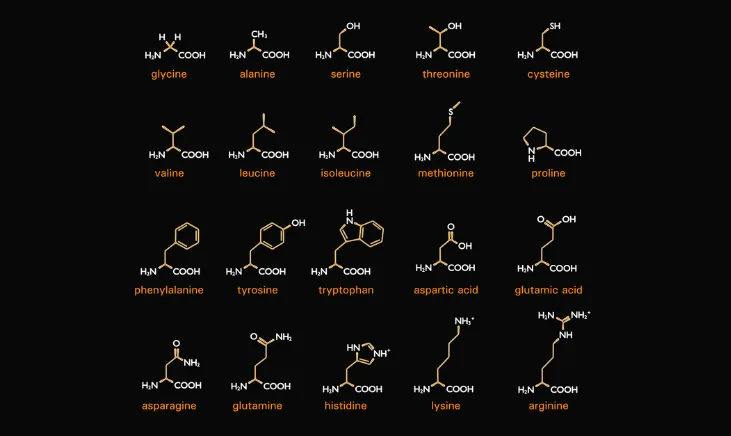
Essential vs. Non-Essential Amino Acids
Our bodies can produce 11 non-essential amino acids, named so not because they aren’t necessary, but because they can create them independently.
However, we also require nine other amino acids that our bodies can’t synthesize. These essential amino acids (EAAs) must come from our diet to support our bodily functions. Animal proteins, like meat and dairy, naturally contain all nine, making them a robust choice for meeting our needs. Plant sources can also offer some EAAs; quinoa and legumes, for instance, are excellent for those following a plant-based diet.
The Building Blocks of Proteins
Proteins are vital to life and serve as the building blocks of cells. They are involved in nearly every process within our cells and are necessary for bodily functions, such as cell repair and the production of enzymes and hormones. When you eat protein, your body breaks it down into individual amino acids, which are then used to build and repair tissues, among other functions.
Proteins are more than just muscle builders. They play an integral role in transporting substances in the bloodstream, helping fight off infections by powering your immune system and even facilitating the oxygen-carrying ability of hemoglobin in blood. Without sufficient amino acids, our bodies would struggle to perform these essential tasks, leading to various health issues.
Want to know the difference between amino acid supplements and protein powder? Learn more here!
Lipids and Fatty Acids
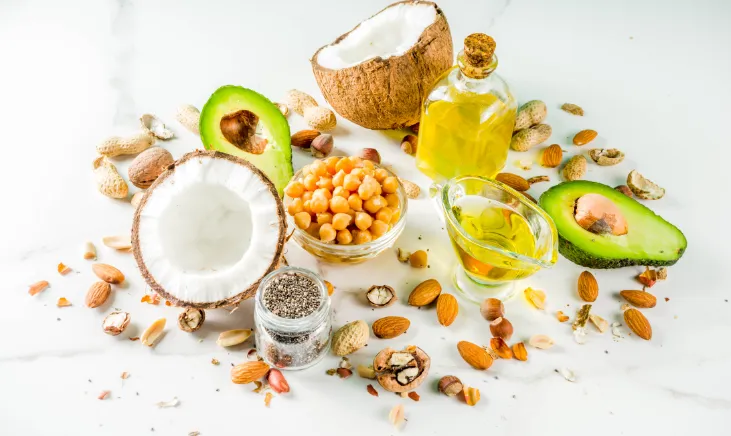
Lipids, often simply referred to as fats, are more than energy reserves. They also include fatty acids, oils, waxes, and specific vitamins essential for health—such as A, D, E, and K.
Lipids are also key components of cell membranes, not just as structural elements but also as key players in cell signaling and metabolic processes. Additionally, many hormones that regulate bodily functions are lipids.
Unlike amino acids that are attracted to water (hydrophilic), lipids are water-fearing (hydrophobic) molecules, which makes them great at forming barriers like the membranes around cells. This characteristic also means they’re stored differently than water-soluble nutrients in our bodies.
What is Fatty Acid?
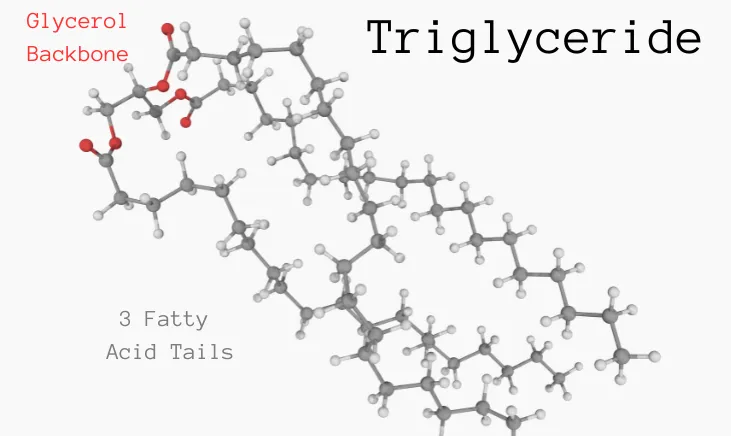
Fatty acids are the building blocks of the fat in our bodies and food. They are a subcategory of lipids that consist of a hydrocarbon chain with a carboxylic acid group at one end. This structure is critical to the energy-yielding property of fats because, when broken down during metabolism, fatty acids release large amounts of energy.
Fatty acids fall into two categories: saturated and unsaturated. Saturated fats are found in animal products and are usually solid at room temperature, while unsaturated fats are typically liquid and come from plants. Eating the right balance of these fats is essential for maintaining good health.
Melting Points of Saturated vs. Unsaturated Fatty Acids
The melting point of a fatty acid can tell us a lot about its properties and how it behaves in our body. Saturated fatty acids have no double bonds between their carbon atoms, which makes them pack tightly and stay solid at room temperature—think butter or lard.
Unsaturated fatty acids, on the other hand, have one or more double bonds, which create kinks in their structure, preventing them from packing tightly and making them liquid at room temperature, like olive oil. These structural differences affect not only their physical state but also their function and impact on health.
How Amino Acids and Fats Fit Into Your Nutritional Needs
Three primary macronutrients play key roles in maintaining our health. These include:
- Carbohydrates
- Proteins (Amino Acids)
- Fats (Lipids)
The Major Nutrients and Where Amino Acids and Fats Fit In
Carbohydrates from grains, fruit, and veggies are the primary energy source for most of our body’s functions. They are easily broken down into glucose, which fuels our cells.
However, when building and repairing tissues, proteins come in, made up of amino acids. These are necessary to create new cells, enzymes, and hormones.
Lipids, or fats, are needed for energy storage capabilities, providing more than twice the energy content per gram compared to carbohydrates or proteins. They are also vital for insulating our bodies and protecting our organs. In addition, lipids make up the cell membrane, giving cells shape and the ability to communicate with one another.
Amino Acids vs. Lipids
The structure of both lipids and amino acids greatly influences its function. Amino acids are organic compounds comprising an amino group, a carboxyl group, and a unique side chain. There are twenty different amino acids, and their various sequences create other proteins involved in almost every biological process.
On the other hand, lipids are characterized by their inability to dissolve in water. They are mainly composed of hydrocarbons, which makes them excellent for storing energy. Fats, oils, waxes, specific vitamins, and hormones are lipids. Structurally, they vary from the long-chain fatty acids found in most fats to the ring-shaped structures in steroids.
The Different Jobs and Sources
| Amino Acids | Lipids | |
| Structure | Composed of a central carbon atom, an amino group (NH2), a carboxyl group (COOH), and a distinctive side chain. | Consists of glycerol linked to three fatty acids (in triglycerides) or a complex structure like sterols. |
| Function | – The primary building blocks of proteins- Building and repairing tissues- Makes enzymes and hormones | – Serve as a primary energy reserve- Offer structural components of cell membranes- Involved in signaling pathways |
| Sources | – Meat, eggs, seafood, dairy, soy, and legumes. – Complete proteins from animal sources and select plant sources like quinoa | – Fats and oils from animals and plants, including butter, oils (olive, canola), nuts, seeds, and fatty fish. |
Key Takeaways on Amino Acids and Lipids
Amino acids are the building blocks of proteins and are crucial for creating and repairing muscle tissue, producing enzymes and hormones, and maintaining overall good health. Lipids are a group of fats and fat-like substances necessary for energy storage, cell structure, and hormone production. Both are vital, serving unique functions that are irreplaceable within the body.
- Amino Acids: Essential for protein synthesis, muscle repair, and metabolic processes.
- Lipids: Key for energy storage, cellular structure, insulation, protection of organs, and hormone production.
Why This Matters for Your Health Goals
Whether your goal is to build muscle, lose weight, or just maintain a healthy lifestyle, it’s helpful to understand how these nutrients come into play.
- Muscle Building: Adequate protein intake from amino acids is essential for muscle growth and repair.
- Weight Management: Understanding the types of lipids and opting for healthy fats can aid in weight control and reduce the risk of heart disease.
- Overall Health: A balanced intake of both nutrients supports a wide range of bodily functions and can help prevent nutritional deficiencies.
Incorporating a good balance of different whole foods in your diet to ensure an adequate supply of amino acids and lipids can lead to better health outcomes. Overall, it’s not just about quantity but also the quality of the nutrients you consume.
Frequently Asked Question
What is the difference between amino acids and lipids?
Amino acids are the organic compounds that join to create proteins, vital for the body’s tissue growth and repair. Lipids, commonly known as fats, serve primarily as energy reserves and are critical components of cellular structures such as membranes.
Are amino acids a protein or lipid?
Amino acids are the building blocks of proteins, not lipids. They link together in various sequences to form proteins, which play many critical roles in the body, including developing muscles and enzymes.
Are fatty acids a type of amino acid?
No, fatty acids are not a type of amino acid. They are a type of lipid used by the body for energy and in constructing cell membranes and signaling pathways.
Why are amino acids and lipids essential for athletes?
Amino acids are fundamental for athletes as they help repair and grow muscle tissue, especially after training sessions. Lipids aren’t just energy sources; they also contribute to vital hormone production, which can influence muscle development and recovery, making them invaluable, particularly in endurance sports.
Thinking about taking an amino acid supplement? Check our our article about their side effects before investing!
Do lipids turn into amino acids?
No, lipids and amino acids are two completely separate molecules with different functions. Both are broken down into energy; however, lipids will not turn into amino acids.
How do amino acids differ from carbohydrates and lipids?
Amino acids are part of the protein group, so they do not fall into the same category as carbohydrates or fats. Each is consumed to provide energy in the form of calories, but they are all different compounds with unique structures and functions. Amino acids, for example, contain a nitrogen atom, which carbohydrates and lipids are lacking.
Is an amino acid a carbohydrate or a lipid?
Amino acids are neither a carbohydrate or a lipid. Rather, they are the compounds that makeup proteins, the third type of macronutrient.
